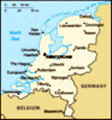Advertisement
Published: April 23rd 2019
On Saturday, Debussy left Middleburg at 2:30 for a long day and overnight back to Amsterdam for. As the weather was marvelous, we spent the entire afternoon outdoors on the top deck, enjoying the sunshine, the cool breeze and the beautiful scenery. After transiting a series of locks, entered a large bay with islands. Hundreds of sailboats were out taking advantage of the unusually wonderful weather on a Saturday afternoon. Fran snapped a picture of some Dutch campers. Occasionally, our relaxation was punctuated with 4 short blasts of the horn which is to remind boaters to get the f out of the way. Boaters can be really stupid. Except for watching, other activities up top included eating and drinking and maybe a little exercise. Fran did a full hour of Yoga and she did a special pose for me and for her grandchildren that get a real kick out of her acting like a youngster.
I want to write to you about the process lock process. A lot of the Netherlands is below sea level. The ocean is kept out by dikes. And commerce originally was all by boat. Roads were mud and often impassable. Beginning in the 1700s, canals
were dug all over Europe. Locks were invented that used only gravity to fill and drain. These locks allowed the canal water to be stable, allowed vessels to move uphill, in effect. They were and remain marvels of engineering. But now, the boats are way bigger. The canals were widened and deepened over the years and the engineering of the locks got more complicated. Still gravity is the primary force used to move now tremendous volumes of water. There is a challenge on the other end too. Moving a 300 foot plus ship into a lock that has front, back and side clearances of just a few feet is something to behold. A photo included here shows us coming toward a lock. The sailboat ahead will go into a smaller lock just to the left of the big lock. There is no room to share space with us.The next photo shows the lock opening.
For those of you who are not boaters, try to picture this. Only the back end of the boat is propelled (with a slight exception to be discussed later). When the rudder is moved and the boat is going forward, pressure is exerted on the
rudder and the stern is directed right or left. If the stern moves to the right the boat points left and vice versa. To get this long ship straight into the lock – it has to be perfectly straight – requires that the front and back of the boat move in unison. To accomplish this, these vessels rely on supplemental propulsion in the form of bow and stern thrusters, electrically driven motors that drive small propellers built into the sides of the hull. They push sideways. Moving a 300 foot plus ship into a lock that has side clearance of just a few feet is something to behold. For those of you who are not boaters, picture this. Only the back end of the boat is propelled. When the rudder is moved and the boat if going forward, the back end is directed. If the stern moves to the right the boat points left and vice versa. To get this long ship straight into the lock – it has to be perfectly straight – requires that the front and back of the boat move in unison. To accomplish this, these ships rely on supplemental propulsion in the form of bow
and stern thrusters, electrically driven motors that drive small propellers built into the sides of the hulls, sideways. As we approach the lock we slow to almost an imperceptible crawl. The captain, and in some cases, the captain in training, opens a control station on either the port or starboard side of the boat, near the bow. Using three knobs, he controls all three thrusters, the gearshift (forward and aft) and the throttle. His vision goes from the stern to the bow and back as he keeps the vessel moving forward within inches of the lock wall. As we approach the lock we slow to almost an imperceptible crawl. The captain opens a control station on either the port or starboard side of the boat, near the bow. Using three knobs, he controls the three thrusters, to stern, one bow, the gearshift (forward and aft) and the throttle. His vision goes from the stern to the bow, to the video monitor which that shows the stern and back again as he keeps the vessel moving slowly forward within inches of the lock walls. Once we are in, we don’t tie off. The captain just keeps using his controls to keep
us in one place. The lock gates close behind us and using gravity, water spills quickly into the lock, floating us higher. When we reach equilibrium with the water in front of us, the gates open and we leave as carefully as we entered. Recall that Holland is mostly below sea levels so as we approach the North Sea, we have to come up several
As evening fell, we passed through a forest of windmills; hundreds of them. They were really beautiful. We went down below to get ready for our special dinner in the Vintage with our new friends from Washington State, the kids we called them.
Advertisement
Tot: 0.141s; Tpl: 0.012s; cc: 13; qc: 60; dbt: 0.0702s; 1; m:domysql w:travelblog (10.17.0.13); sld: 1;
; mem: 1.2mb







